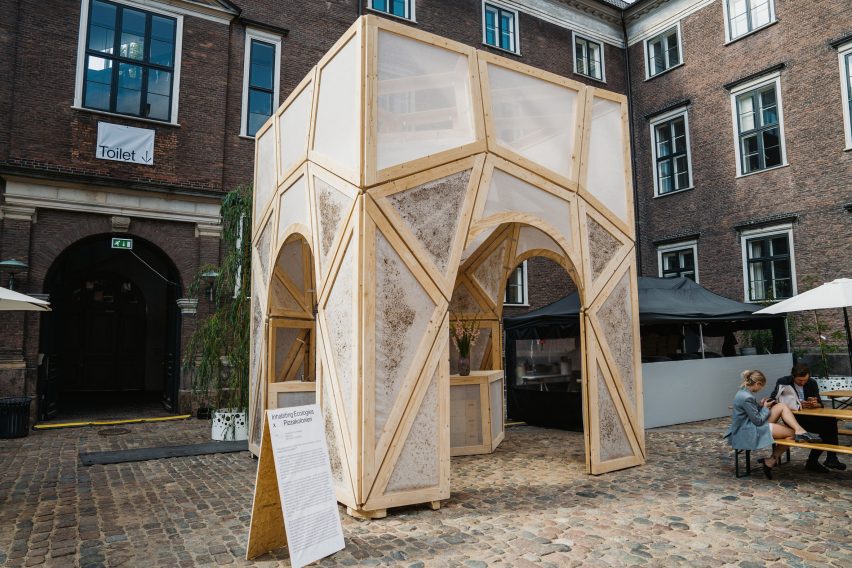Architects Nikolaj Emil Svenningsen and Sean Lyon and designer Søs Christine Hejselbæk have created a pavilion wrapped in textiles embedded with mycelium at Chart Art Fair, which was captured in this short video produced as part of the Dezeen x Chart Art Fair 2022 collaboration.
Called Inhabiting Ecologies, the structure is one of five temporary pavilions installed in the courtyards of the Charlottenborg mansion during the 10th annual edition of Chart Art Fair in Copenhagen.
The Chart Art Fair pavilion is made from textile and wood
The pavilion was built using a series of geometric cuts of organic Kvadrat textiles stretched in wooden frames made from surplus wood stock donated by sustainable wood supplier Superwood.
The textile has been embedded with mycelium spores that feed on a substrate of sawdust and coffee grounds in order to grow and spread across the material.
A compostable algae-based biopolymer was used to bond the textiles to the wooden frames and, when assembled, they create an abstract structure inspired by the neo-classicist architecture of Charlottenborg.
The pavilion was designed by architects Svenningsen, Lyon and Heiselbæk, who aimed to examine "how natural and man-made structures might cohabitate".
Its design team told Dezeen that the addition of mycelium spores to the structure is "an experimental feature" and that it sought to investigate its architectural properties through its implementation, as well as suggest its environmental benefits over traditional building materials.
"We hope to learn what it has to offer in terms of ornament, patination, light filtration and tactility," the design team said.
"Mycelium provides key advantages to traditional building materials such as low cost, density and energy consumption. In addition to this, its biodegradability ensures a low environmental impact and carbon footprint."
The generative growth of the mycelium was also a point of interest for the designers who thought of it as an active participant in the design process.
"By making use of the productive attributes of this fungal network, we are inviting nature into the pavilion and surrendering the architectural agency to mycelium’s creative process," they said.
During the fair, the pavilion acted as a restaurant serving mushroom pizza to visitors. According to the design team, it was designed to be disassembled at the end of the fair and have its materials repurposed.
It was built as part of Chart Art Fair's annual architecture competition, which invited proposals set to the theme of bio-architecture to provoke a discussion surrounding the symbiotic relationship between architecture and nature.
"Inhabiting Ecologies is inviting you to rethink current systems and ways of manufacturing as well as proposing a symbiotic relationship with nature within the built environment," the designers said of their pavilion.
The five pavilions were selected by a jury of architects and design specialists including BIG founder Bjarke Ingels, Snøhetta co-founder Kjetil Trædal Thorsen, speculative designer Pleun van Dijk, curator Maria Foerlev, author Ditte Lysgaard Vind and artist Johanne Hestvold. The jury will choose an overall winner at the end of the fair.
Also displayed at Chart Art Fair was a wooden pavilion with a seaweed roof that explores the structural potential of carbon-capturing technologies and an A-frame-shaped structure using timber and hemp that references an HC Andersen fairytale.
Now in its 10th year, Chart Art Fair is an annual event comprising exhibitions, talks, performances, music and book fairs, bringing together art enthusiasts, design professionals and collaborators.
The photography is by Joakim Züger/Barks Projects.
Chart Art Fair took place from 26 to 28 August 2022 in Copenhagen, Denmark. See Dezeen Events Guide for an up-to-date list of architecture and design events taking place around the world.
Partnership content
This article was written as part of a partnership with Chart Art Fair. Find out more about our partnership content here.

